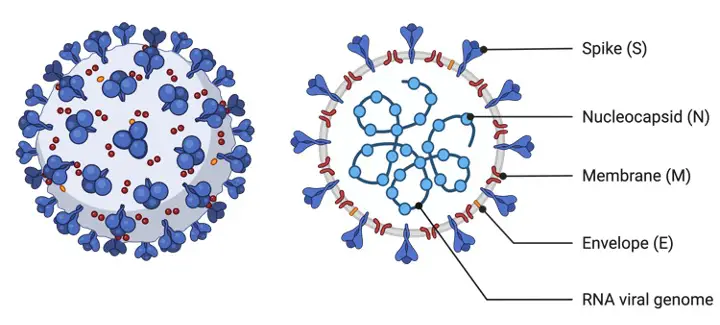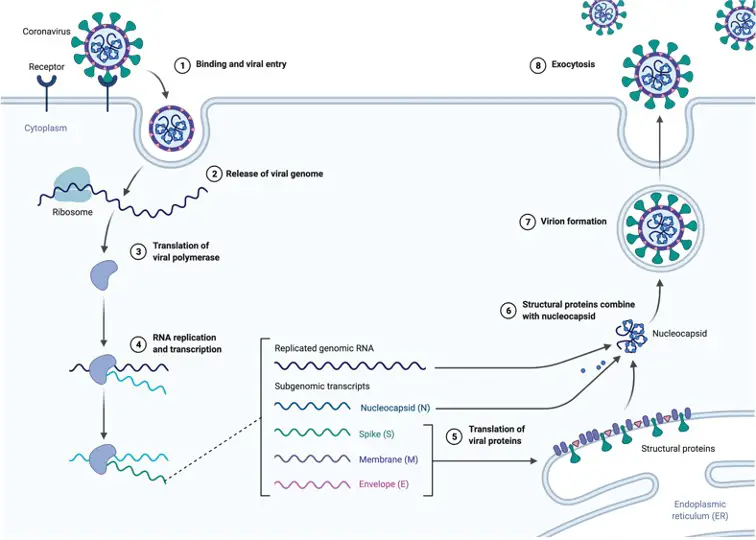Table of Contents
Coronavirus Definition
Coronavirus Illness 2019 (COVID-19) is a contagious coronavirus disease that was initially discovered in Wuhan, China, in 2019. It has subsequently spread to other nations, earning it pandemic status in 2020. COVID-19 emerged in the end of 2019 as an emerging infectious illness caused by a novel coronavirus (dubbed nCOV at the time) that is different from previously known coronaviruses.
What is Coronavirus?
According to the official notification to the World Health Organization, the first verified COVID-19 case was in December from a resident of Wuhan, Hubei, China (WHO). However, earlier occurrences (as early as mid-November) may exist but have gone unnoticed. When the number of cases began to rise at an alarming rate, scientists quickly focused their research efforts on understanding the sickness and the virus that was causing it.

The COVID-19 agent was eventually discovered to be a member of the coronavirus family. SARS-CoV (which produced the SARS outbreak in 2002-2004), MERS-CoV (which caused MERS outbreaks in 2012, 2015, and 2018), and common-cold coronaviruses are all coronaviruses. Its enormous, single-stranded RNA genome is its most distinguishing feature.
Scientists anticipated the probable development of a new coronavirus strain capable of producing a similar pandemic more than a decade ago.
Because of its resemblance to SARS-CoV, the coronavirus that causes COVID-19 was formally designated SARS-CoV-2 (severe acute respiratory syndrome coronavirus 2) in February 2020.
Coronavirus Signs and Symptoms
Fever and cough are the most common symptoms in COVID-19 patients. However, after a week, another symptom, shortness of breath, appears. Fatigue, sore throat, palpitations, chest tightness, headache, myalgia, malaise, sneezing, runny nose, nausea, anorexia, vomiting, diarrhoea, and abdominal discomfort are some of the other common symptoms. These signs do not cover everything. When many of these symptoms appear, notably shortness of breath, get medical help right away.

From the moment the virus is contracted, the incubation period is usually 5 to 6 days. Symptoms may occur up to 14 days after infection in certain cases. Some people who are infected with the virus may not show any symptoms at all. They’re known as “asymptomatic” patients (as opposed to the symptomatic).
Many of the COVID-19 individuals who are symptomatic have minor symptoms and can heal at home. The aged and immunocompromised people, on the other hand, tend to experience more severe symptoms. When the illness advances to serious consequences, such as pneumonia, septic shock, or multi-organ failure, it becomes critical, and the chances of mortality increase.
Diabetes, hypertension, heart disease, and chronic respiratory disease are among pre-existing diseases that might exacerbate COVID-19 symptoms. In mild cases, symptoms usually last about two weeks. The symptoms of a severe or critical condition, on the other hand, can last anywhere from three to six weeks.
Coronavirus Diagnosis
COVID-19’s initial symptoms are similar to those of the common flu, so it’s easy to confuse the two. As a result, a reliable COVID-19 diagnostic test is essential. Currently, there are two main methods for testing for COVID-19: There are two types of molecular recognition: (1) molecular recognition and (2) serology testing.
The first method, which is considered the gold standard, employs molecular techniques such as real-time PCR and nucleic acid tests. SARS-CoV-2 genetic material can be detected in the collected specimens (Swabs from the nasopharyngeal and oropharyngeal cavities, sputum samples, endotracheal aspirate, bronchoalveolar lavage, blood, stool, and urine are just a few examples.).
N, E, S, and RdRP genes are among the viral genes targeted. Serology testing is a diagnostic procedure that looks for antibodies in the body of the patient. B cells, in particular, respond to any antigen they come across. As a result, if it detects SARS-CoV-2 inside the body, it produces antibodies that attack the virus specifically. Antibody test kits, such as ELISA, can detect the presence of such antibodies.
This test, on the other hand, is only useful for surveillance and confirmation procedures. Molecular recognition is currently preferred in this regard because it is useful not only in confirming the presence of SARS-CoV-2 but also in determining active infections.
Coronavirus Prevention
On a global scale, the spread of the virus is slowed by imposing travel restrictions and limiting tourist entry. Local communities’ social ties are severed through the implementation of social distancing, isolation, and quarantine protocols.
Except for hospitals, pharmacies, convenience stores, and food services, mass gatherings are prohibited and businesses are closed. The use of public transportation has been restricted to healthcare workers. Staying at home is suggested for those who have not been afflicted with the virus.
Proper cleanliness, hydration, eating nutritious food, and maintaining a better lifestyle, such as working out, avoiding alcohol and smoking, and getting enough sleep, are all examples of preventative actions on a personal level. Regular hand washing (at least 20 seconds with soap and water), the use of sanitizers and alcohols (at least 60%) as needed, and avoiding touching the face with unwashed hands are all part of good hygiene.
Wearing masks can also help prevent the infection from spreading. Spitting should be avoided at all costs. All of these efforts are in place to “flatten the curve,” giving healthcare institutions more time to absorb and manage the increased patient load.
Coronavirus Vaccine
As of early 2020, there is no vaccine available for COVID-19. Researchers are still working on a vaccine that is both effective and safe. To guarantee that a new vaccination is effective and has no side effects, it might take a long period to develop.
Researchers are rushing to come up with a solution because of the pandemic’s status and the growing number of fatalities. Clinical studies are scheduled to begin in March 2020. The first clinical trial in the United States began on March 16. Nonetheless, at the present pace, the COVID-19 vaccine will be available for general use in one to one-and-a-half years.
Coronavirus and Passive Antibody Therapy
Passive antibody therapy is another treatment option. Antibodies from the blood donated by people who recovered from COVID-19 will be used to neutralise SARS-CoV-2 in this type of treatment. As a result, the serum could be used to trigger an immune response that protects against the virus. It is in the developing phase as well.
Coronavirus Citations
- Human Coronavirus: Host-Pathogen Interaction. Annu Rev Microbiol . 2019 Sep 8;73:529-557.
- COVID-19: The first documented coronavirus pandemic in history. Biomed J . 2020 Aug;43(4):328-333.
- Lessons for COVID-19 Immunity from Other Coronavirus Infections. Immunity . 2020 Aug 18;53(2):248-263.
- Figures are created with BioRender.com







